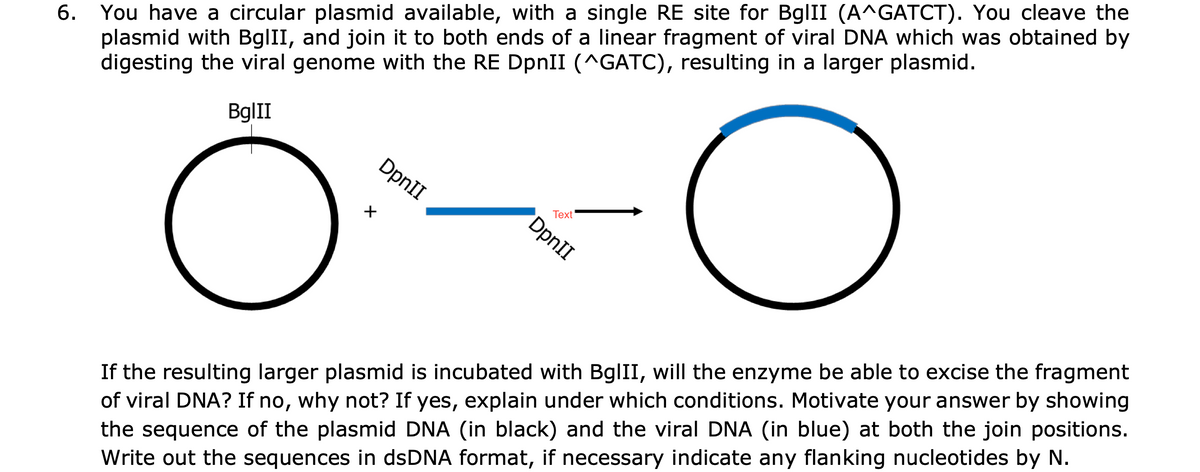BglII 6. You have a circular plasmid available, with a single RE site for BglII (A^GATCT). You cleave the plasmid with BglII, and join it to both ends of a linear fragment of viral DNA which was obtained by digesting the viral genome with the RE DpnII (^GATC), resulting in a larger plasmid. ☑ DpnII Text DpnII O If the resulting larger plasmid is incubated with BglII, will the enzyme be able to excise the fragment of viral DNA? If no, why not? If yes, explain under which conditions. Motivate your answer by showing the sequence of the plasmid DNA (in black) and the viral DNA (in blue) at both the join positions. Write out the sequences in dsDNA format, if necessary indicate any flanking nucleotides by N. 7. Consider the following plasmid (size 6700 bp), with restriction sites at the positions indicated: BamHI + 1 6700 bp 2800 3500 EcoRI BamHI Probe
BglII 6. You have a circular plasmid available, with a single RE site for BglII (A^GATCT). You cleave the plasmid with BglII, and join it to both ends of a linear fragment of viral DNA which was obtained by digesting the viral genome with the RE DpnII (^GATC), resulting in a larger plasmid. ☑ DpnII Text DpnII O If the resulting larger plasmid is incubated with BglII, will the enzyme be able to excise the fragment of viral DNA? If no, why not? If yes, explain under which conditions. Motivate your answer by showing the sequence of the plasmid DNA (in black) and the viral DNA (in blue) at both the join positions. Write out the sequences in dsDNA format, if necessary indicate any flanking nucleotides by N. 7. Consider the following plasmid (size 6700 bp), with restriction sites at the positions indicated: BamHI + 1 6700 bp 2800 3500 EcoRI BamHI Probe
Biology: The Unity and Diversity of Life (MindTap Course List)
15th Edition
ISBN:9781337408332
Author:Cecie Starr, Ralph Taggart, Christine Evers, Lisa Starr
Publisher:Cecie Starr, Ralph Taggart, Christine Evers, Lisa Starr
Chapter15: Studying And Manipulating Genomes
Section: Chapter Questions
Problem 2SQ
Related questions
Question

Transcribed Image Text:BglII
6. You have a circular plasmid available, with a single RE site for BglII (A^GATCT). You cleave the
plasmid with BglII, and join it to both ends of a linear fragment of viral DNA which was obtained by
digesting the viral genome with the RE DpnII (^GATC), resulting in a larger plasmid.
☑
DpnII
Text
DpnII
O
If the resulting larger plasmid is incubated with BglII, will the enzyme be able to excise the fragment
of viral DNA? If no, why not? If yes, explain under which conditions. Motivate your answer by showing
the sequence of the plasmid DNA (in black) and the viral DNA (in blue) at both the join positions.
Write out the sequences in dsDNA format, if necessary indicate any flanking nucleotides by N.

Transcribed Image Text:7.
Consider the following plasmid (size 6700 bp), with restriction sites at the positions indicated:
BamHI
+
1
6700 bp
2800
3500
EcoRI
BamHI
Probe
Expert Solution
This question has been solved!
Explore an expertly crafted, step-by-step solution for a thorough understanding of key concepts.
Step by step
Solved in 2 steps

Recommended textbooks for you

Biology: The Unity and Diversity of Life (MindTap…
Biology
ISBN:
9781337408332
Author:
Cecie Starr, Ralph Taggart, Christine Evers, Lisa Starr
Publisher:
Cengage Learning

Biology: The Dynamic Science (MindTap Course List)
Biology
ISBN:
9781305389892
Author:
Peter J. Russell, Paul E. Hertz, Beverly McMillan
Publisher:
Cengage Learning

Biology: The Unity and Diversity of Life (MindTap…
Biology
ISBN:
9781337408332
Author:
Cecie Starr, Ralph Taggart, Christine Evers, Lisa Starr
Publisher:
Cengage Learning

Biology: The Dynamic Science (MindTap Course List)
Biology
ISBN:
9781305389892
Author:
Peter J. Russell, Paul E. Hertz, Beverly McMillan
Publisher:
Cengage Learning